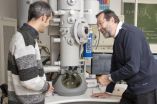(Press-News.org) Over the last decade there has been an increased interest in developing resonators for gravitmetric sensing; however, the sensors' response to variations in temperature has prevented them from being used outside the laboratory. New sensors developed by researchers at the University of Cambridge negate the effects of temperature so that they may be used in industries including health care, telecommunications and environmental monitoring.
Sensors built from high frequency bulk acoustic wave (BAW) resonators consist of a piezoelectric layer sandwiched between two electrodes, to which a variable frequency signal is applied. The resonator vibrates at a given frequency, and the properties of the resulting acoustic wave allow researchers to determine what is occurring in the environment.
The main application of these nanoscale sensors is to measure a mass load. By tracking changes in the acoustic wave, mass changes on the sensors can be detected. The resonators can be altered to detect a number of different things, from antigens/antibodies to environmental contaminants.
The major issue which has prevented the adoption of these resonators in commercial sensing applications has been their unwanted response to temperature. When the temperature changes, the acoustic wave changes along with it, so it is impossible to determine whether the change has been motivated by something the resonator is trying to detect or a change in temperature. For this reason, the use of these resonators has been limited to laboratories where environmental conditions can be tightly controlled.
Many researchers have attempted to compensate for the effects of temperature, but as these effects are non-linear, they can only be minimised, not eliminated completely. Now, researchers from the Department of Engineering have designed a thin film bulk acoustic wave resonator that allows simultaneous measurement of temperature and mass loading in a single device. The resonator has been designed so that it has two resonances which react differently to mass and temperature changes.
"This has two consequences," says Dr Luis Garcia-Gancedo, a member of Dr Andrew Flewitt's group in the Department of Engineering. "First, we are able to eliminate the effects of temperature completely regardless of its non-linearity. Secondly, we are able to measure mass and temperature with extremely high sensitivity at exactly the same location, which we haven't been able to do before."
With the assistance of Cambridge Enterprise, the team is looking at two primary applications for the resonators: biological systems and physical sensing. The resonators could be used for applications such as detecting viruses in a health care setting, or contaminants in drinking water. Other potential applications include air quality or pressure monitoring.
The resonator is able to detect masses to the order of 10-15 grams, which is approximately the size of one virus. The size of the resonator (typically a few micrometres square) means that they can easily be embedded in various devices.
"One of the problems with existing sensing technology is that if you're trying to measure two different physical properties, the sensors are often based on two different mechanisms," says Dr Garcia-Gancedo. "The integration of two different sensing mechanisms means that you often end up with a bulky item. But what we have developed uses exactly the same technology with exactly the same electronics, without any increase in size."
INFORMATION:
Cambridge Enterprise is currently seeking commercial partners for developing this technology.
This press release is available in German.
Nowadays, electron microscopes are an essential tool, especially in the field of materials science. At TU Vienna, electron beams are being created that possess an inner rotation, similarly to a tornado. These "vortex beams" cannot only be used to display objects, but to investigate material-specific properties - with precision on a nanometer scale. A new breakthrough in research now allows scientists to produce much more intense vortex beams than ever before.
Quantum Tornado: the Electron as a Wave
In a tornado, the individual ...
DETROIT— There has been great advancements in the development of the high-strength steel and the need for additional enhancements continue to grow. Various industries have a need for structural components that are lighter and stronger, improve energy efficiencies, reduce emissions and pollution increase safety and cost less to produce, particularly in the automotive industry.
A group of researchers in Wayne State University's College of Engineering have been working to create advanced materials with high-yield strength, fracture toughness and ductility. Their efforts ...
DURHAM, N.C. – The cause of heart attacks or strokes among some patients treated with anti-platelet drugs may be different than for patients who have undergone surgical procedures to restore blood flow, according to researchers at Duke Medicine.
The finding -- reported Nov. 4, 2012, at the American Heart Association's Scientific Sessions annual meeting and published in the Journal of the American Medical Association – provides new insights into a subset of heart patients with acute coronary syndromes (ACS) whose risk for cardiovascular events remained unchanged despite ...
A cockatoo from a species not known to use tools in the wild has been observed spontaneously making and using tools for reaching food and other objects.
A Goffin's cockatoo called 'Figaro', that has been reared in captivity and lives near Vienna, used his powerful beak to cut long splinters out of wooden beams in its aviary, or twigs out of a branch, to reach and rake in objects out of its reach. Researchers from the Universities of Oxford and Vienna filmed Figaro making and using these tools.
How the bird discovered how to make and use tools is unclear but shows how ...
Clinicians should take caution when diagnosing a child who has a high fever and whose tests show evidence of adenovirus, and not assume the virus is responsible for Kawasaki-like symptoms. According to a new study from Nationwide Children's Hospital appearing in Clinical Infectious Diseases, adenovirus detection is not uncommon among children with Kawasaki disease.
Kawasaki disease is a rare but serious condition in children that involves inflammation of the blood vessels, specifically the heart vessels that supply the heart tissue or coronary arteries. It is the most ...
This press release is available in Spanish.
A tip about a folk remedy plant used in India and Africa to ward off bugs has led to the discovery of insect-repelling compounds.
U.S. Department of Agriculture (USDA) scientists have identified components of Jatropha curcas seed oil that are responsible for mosquito repellency. Researchers at the Agricultural Research Service (ARS) Natural Products Utilization Research Unit (NPURU) in Oxford, Miss., often find effective plant-derived compounds to deter insects by gathering plants in the wild and investigating those used ...
CHAMPAIGN, Ill. — Adopting a loser-pays-all rule for criminal litigation would likely be feasible only if the rule applied to defendants who are wealthy, says a study from a University of Illinois law professor.
Nuno Garoupa, the H. Ross and Helen Workman Research Scholar in the College of Law, says a loser-pays-all rule could deter some crime when it's applied to either a corporation or an individual with deep pockets. But when defendants are not wealthy, such cost-shifting would be "wholly inappropriate," he says.
"On the defendant's side, the problem is that a significant ...
The use of the World Health Organization's Surgical Safety Checklist in the operating room considerably lowers the risks of surgery. This is the conclusion of Axel Fudickar and co-authors in their article in Issue 42 of Deutsches Ärzteblatt International (Dtsch Arztebl Int 2012; 109(42): 695).
The most common errors in safety-related behavior in the operating room are attributable to inadequate communication and teamwork. The Surgical Safety Checklist, which was introduced by the World Health Organization in 2007, has the main effect of improving commmunication of the ...
A new University of Colorado Boulder study shows for the first time that episodes of reduced precipitation in the southern Rocky Mountains, especially during the 2001-02 drought, greatly accelerated development of the mountain pine beetle epidemic.
The study, the first ever to chart the evolution of the current pine beetle epidemic in the southern Rocky Mountains, compared patterns of beetle outbreak in the two primary host species, the ponderosa pine and lodgepole pine, said CU-Boulder doctoral student Teresa Chapman. The current mountain pine beetle outbreak in the ...
New Rochelle, NY, November 5, 2012—Spinal cord injury (SCI) can disrupt the body's sensitive signaling mechanisms that control blood pressure, breathing, and oxygen delivery to the heart and other organs during changes in body position. Cardiovascular (CV) disease is a leading cause of illness and death following SCI, and changes in baroreflex sensitivity—the body's ability to detect and respond to changes in blood pressure—may be predictive of a CV event. A comprehensive review article on baroreflex sensitivity after SCI is published in Journal of Neurotrauma, a peer-reviewed ...



